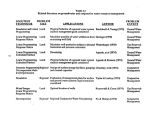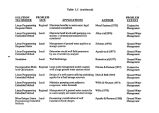| OCR Text |
Show a) Wet or average year ( U) : uniform demand for 10 years with spatial pattern specified using 1982 or historical average annual demand for the years 1969 to 1982. The annual demand Qi( t) for area i, in year t is specified as Qi( t)- aQi0 ( 3.26) where Qi0 is the base ( historical average or 1982) demand for area i, and a is a coefficient greater than or equal to 1. b) Linearly increasing demand because of population growth ( L) : demand increased by 5% of 1982 demand each year over a 10 year planning period with the 1982 spatial demand pattern. The annual demand Qj( t) for area i, in year t is specified as Qi( t) = ( a+ bt) Qi0 ( 3.27) where b is a constant fractional increase in demand in each year. c) Drought condition ( D) : demand increases then decreases linearly during a 10 year drought starting from either of the base spatial demand distributions ( 1982 or historical annual average pumping). The annual demand Qj( t) for area i, in year t is specified as { T ( a + bt) Qi0 fort= l... T , urr s. r, * T * ( 3- 28) ( a + b( T- t)) Qi0 fort- y T where T is the duration of the planning period. Table 3.6 lists all the demand scenarios for which results were obtained for the Salt Lake County aquifer system, as well as some characteristics of the solutions obtained. The results for each demand condition listed are first summarized and analyzed. The general trends apparent from these parametric evaluations are then discussed. 3.3.1 Results from Applications For this application set, 10 water supply agencies, 16 inter- agency boundaries ( listed in Figure 3.4), and 18 boundary segments for water quality maintenance were considered. For the ten year planning period, 47 well nodes are considered for pumping decisions each year leading to 470 decision variables. A total of 181 constraints - 47 drawdown constraints, 100 demand ( demands for each of 10 agencies for each of 10 years) constraints, 18 contamination control flow constraints, and 16 boundaries flow constraints result. All the decision variables and flow constraints were considered to have upper and lower bounds. Lower bounds of 0, and upper bounds of 3 or 9 times the base pumping were set for each decision variable. A ± 5% variability from the the 1969- 1982 historical record was allowed in the flow constraint right hand sides. The maximum permissible drawdown with reference to no pumping was specified as 100 or 150 feet depending on the demand pattern and drought severity considered, as indicated in Table 3.6. The spatial distribution of demand over the water agencies for the two base demand conditions - 1982 pumping and average historical 1969- 1982 pumping is shown by Figures 3.8 and 3.9. Since the flow constraints ( water rights and contamination) are imposed with respect to the historical record, the purpose of the runs with the 1982 base demand is to examine the sensitivity of the optimal solution to changes in the spatial distribution of demand. It would be expected that the flow constraints would have a restricting influence on the solution if 57 |











































































































































































































